Article and photos by Joe Sapia
Note: The yard references are to my house in the section of Monroe between Helmetta and Jamesburg in South Middlesex County. My yard is in a Pine Barrens outlier on the Inner Coastal Plain, the soil is loamy, and my neighborhood is on the boundary of Gardening Zones 6b (cooler) and 7a (warmer). Notes and photographs are for the period covered, unless otherwise noted.
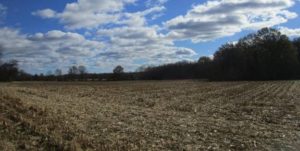
Farmers are harvesting field corn as fall turns into winter. Here, a cut-down cornfield in Monroe, Middlesex County. We have seen a wide fluctuation of temperatures this fall, from summer-like to winter-like, but look out for long days of cold, perhaps accompanied by snow.
FARMING: Look for the traditional farming season to wrap up. Farmers are continuing to harvest field corn, for example. Meanwhile, we are transitioning into the winter holidays season at Christmas tree farms.
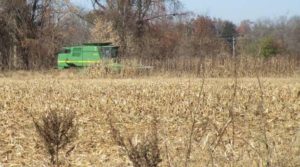
A farmer works a corn field outside Neshanic Station, Somerset County.
CHRISTMAS TREE FARMS: For those seeking trees from local farms, whether recent cuts or cut-your-own, here is the New Jersey Christmas Tree Growers Association website’s farm locater, https://njchristmastrees.net/find-a-farm/. Keep in mind, all Christmas tree farms may not be listed. (I heard an interesting radio news report regarding Christmas trees in America. The report said we are facing the effects of the recession 10 years ago – that is, with the recession, farmers planted less trees and with those trees now reaching cutting time, there are less trees. In turn, higher prices. The report said this will go on for years.)
DEER RUT: While I have not noticed any bucks roaming lately — because, I suspect, the mating season, or rut, of deer, “Odocoileus virginianus,” is peaking and bucks and receptive does are holed up in the seclusion of woods — I did come across a dead buck on farmland in Monroe, Middlesex County. It was a fresh kill and near a busy road, so he probably was a victim of a motor vehicle accident. Additionally, he was probably sex-crazed and less wary, crossed the road, and got hit. I noticed the dead buck because nature was taking its course and vultures were feasting upon him. Definitely turkey vulture, “Cathartes aura”; Maybe black vulture, “Coragyps atratus,” too.
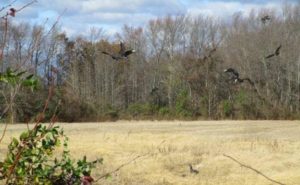
I spooked these vultures when I stopped to photograph them on a deer carcass in Monroe, Middlesex County. Notice the dead buck on the middle-to-right bottom of the photograph.
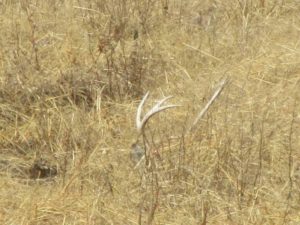
The dead buck appeared to be a pretty good size.
DEER HUNTING: Various deer-hunting seasons have been underway and will continue into 2018, with “Deer Week,” or the Six-Day Shotgun Season, being Monday, December 4, to Saturday, December 9. (If you are traveling through the Pine Barrens, take note of those primitive buildings that are quiet for 51 weeks of the year. During Deer Week, they will be hopping.) Anyway, be careful if heading into the woods during deer seasons. One, it might be advisable to stay out of the woods. Two, if you are in the woods, at least wear blaze orange. Three, during Deer Week, just stay out of the woods unless you are hunting. A year or so ago, I walked underneath a bowhunter in a deer-stand, never seeing him until he spoke to me from above. Fortunately, I wore blaze orange and was obvious to him. This rattled me into thinking I am not as aware of my woods surroundings as I should be.
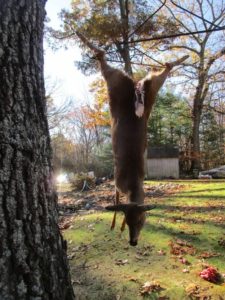
This doe was killed in the Route 33 area of Manalapan, Monmouth County.
FALL FOLIAGE: The Jersey Midlands are past the peak of the changing colors of fall, but there were some beautiful brown/Earth-tone views.

Fall foliage and a cloudy sky at Westminster Cemetery in Cranbury, Middlesex County.

A sunny day upon the fall foliage along Manalapan Brook in Monroe, Middlesex County.
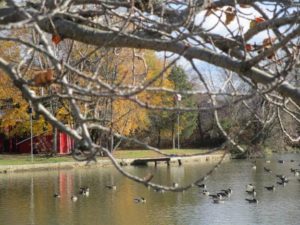
“Englishtown Lake” (properly Lake Weamaconk) in Monmouth County. The lake is formed by the damming of Weamaconk Creek, part of the Raritan River-Bay watershed.
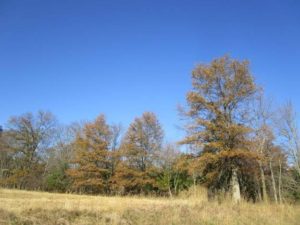
Farmland below Sourland Mountain in Montgomery, Somerset County.
SOURLAND MOUNTAIN: This week, I had to go to Hillsborough, Somerset County, to attend a funeral service. Because I was nearby, I took a ride to Sourland Mountain on the boundary of Somerset, Hunterdon, and Mercer counties. Sourland Mountain, also known as Neshanic Mountain and Zion Mountain, sits on the Piedmont geological area. It runs about 10.5 miles by 4.5 miles and rises about 570 feet above sea level, with its surrounding lowlands as low as about 90 feet above sea level.

Looking across farmland at Sourland Mountain at Montgomery, Somerset County.
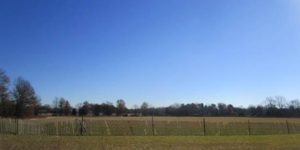
Fencing to hold back snow drifting on roads at Montgomery, Somerset County.
RARITAN RIVER SOUTH BRANCH: The South Branch of the Raritan River is 51 miles long, draining 276 square miles in Somerset, Hunterdon, and Morris counties. It meets the North Branch north of Neshanic Station, forming the main stem of the Raritan River.
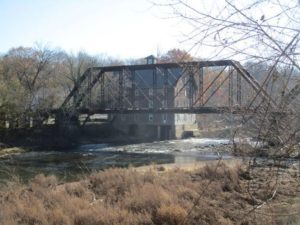
An old railroad bridge and mill on the South Branch of the Raritan River at Neshanic Station.
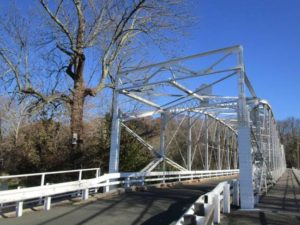
The one-lane, 1896 iron bridge over the South Branch of the Raritan River, connecting Branchburg and Hillsborough at Neshanic Station, Somerset County.
VOICES FROM AFIELD, EAGLES: Michael Franken checked in regarding bald eagles, “Haliaeetus leucocephalus.” He reported seeing them on the boundary of Cranbury and Plainsboro, Middlesex County, Thanksgiving Day and Black Friday. In New Jersey, the bald eagle is “endangered,” or in immediate peril, as a breeder and “threatened,” or if conditions continue or begin to deteriorate, they will advance to endangered, in general. The state Division of Fish and Wildlife bald eagle page is http://www.state.nj.us/dep/fgw/ensp/pdf/end-thrtened/baldeagle.pdf.
DRIVE-BY NATURALIST, BIRD OF PREY: I was driving through a farming area of South Brunswick, Middlesex County, and came across a bird of prey perched in a tree. I could not get a good look or a good photograph of the bird. Later, in looking at the photo on my computer, the bird’s head appeared to be somewhat, perhaps not that blatantly, lighter than the body. A bald eagle, “Haliaeetus leucocephalus,” transitioning from juvenile to adult?
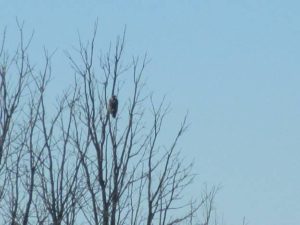
A bald eagle, “Haliaeetus leucocephalus,” transitioning from juvenile to adult?
FULL MOON: The upcoming full moon — the Full Long Night Moon on the December 3-4, Sunday-Monday overnight — will be 2017’s only full “super moon,” that is, when the full moon comes close to the Earth, or 222,443 miles away. The closest will be at 4 a.m. Monday, December 4, when the moon will appear “about 7 percent larger and 16 percent brighter than usual,” according to the National Geographic.

Around 5 p.m. November 20, Monday, or a short time after sunset, there was a beautiful rainbow-shaped and -colored cloud in the western sky. The color was caused by the reddish sunlight from under the horizon hitting the cloud. And more toward the southwest was the crescent moon. What a view! (The photos, all shot from my yard, from where I have watched the night sky since the American-Soviet “Space Race”: the moon, stars, planets, meteorites, and the International Space Station.)
DARK SKIES: As you probably can tell, I am a big fan of a dark sky, to be able to see the stars, planets, satellites clearly. When I remodeled my house over the summer, I insisted on shielded outside lighting, which directs my three outside lights downward, not horizontally or upward. (At night, a shielded light will emit a cone of light, while an unshielded light emits a blinding burst of light. Also, red and green lights protect night vision.) On Saturday, November 25, I heard this story on NPR, about a proposal for part of Idaho to get recognized by the International Dark-Sky Association as a “dark sky reserve,” https://www.npr.org/2017/11/25/566074921/idaho-dims-the-lights-for-one-of-the-best-night-skies-anywhere. Go, Idaho! (I plan to be in Idaho for a wedding in August and hope to see that Idaho dark sky. Give people a wonderful view – turn off lights that project into the sky!)
AROUND PEDDIE LAKE: There were some nice views at Peddie Lake at Hightstown, Mercer County. The lake is about 15 acres, created by the damming of Rocky Brook, part of the Raritan River-Bay watershed. The Peddie School, a preparatory school, sits along the lake.

A fisherman on Peddie Lake under a partly cloudy sky.
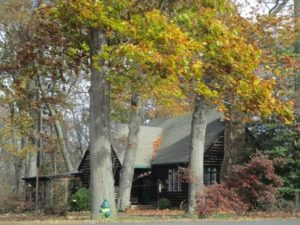
The Peddie Lake cabin.
PROTECTING THE JERSEY MIDLANDS: The Jersey Midlands are an incredible environmental resource: the Atlantic Ocean and other coastal waters, the Outer and Inner Coastal Plains, the Piedmont, the Pine Barrens, the Delaware River, valuable farmland. This alone is evidence of why we should protect the Midlands environment. But, more so, the area is under intense development pressure and stress because of its location at the New York City and Philadelphia metropolitan areas.
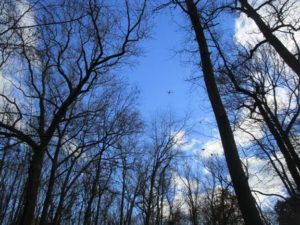
Despite the beauty here of the blue sky above the Manalapan Brook floodplain in Monroe, Middlesex County, notice the commercial jet in the sky, probably headed for Newark Airport. The Midlands are under intense stress because of they are part of both the New York City and Philadelphia metropolitan areas.
OCEAN TEMPERATURE: The Atlantic Ocean temperature at Sandy Hook was about 47 degrees over the November 25-26, Saturday-Sunday, weekend.
SUNRISE/SUNSET: For November 26, Sunday, to December 2, Saturday, the sun will rise about 6:55 to 7:05 a.m. and set about 4:30 to 4:35 p.m. For Sunday, December 3, to Saturday, December 9, the sun will rise about 7:05 to 7:10 a.m. and set about 4:30 p.m.WEATHER: The National Weather Service forecasting station for the area is at http://www.weather.gov/phi/.
CLOUDS: This week’s cloud photographs were captured at Monroe and Jamesburg, Middlesex County.

“Jamesburg Lake” (properly Lake Manalapan), looking from Monroe toward Jamesburg, Middlesex County.
IN THE GARDEN AND YARD: I try to get the yardwork done by Thanksgiving weekend. So far, the lawn has been cut for the last time, shrubs have been spruced up in the front yard, the gutters and drainpipes have been cleaned in the front of the house, the crawlspace where a two-room addition was put on the house circa 1967 has been secured, and the garage door and front cellar window well has been cleaned. Still to go, sprucing the backyard shrubs, cleaning the rear gutters and drainpipes, raking leaves into the garden, and, perhaps, roto-tilling the garden. I will not get the outside painting I had planned done. As the outside work ends, I have a ton of stuff to do inside over the winter.

The garden in my backyard in August.
 This week in the garden.
This week in the garden.
UNEXPECTED WILDLIFE REFUGE: A little south of the Jersey Midlands, in Atlantic County, are our friends at the Unexpected Wildlife Refuge. Veronica Van Hof, the director, is seeking help in meeting a challenge. “As another way of supporting the Refuge, we have been accepted to be part of the Newman’s Own Foundation $500,000 Holiday Challenge, administered through CrowdRise,” Veronica said. “Every donation (‘voting’) through our page at CrowdRise increases the chance of our receiving additional funding through one of the Challenge prizes which range from $2,500 for 10th place up to $150,000 for first place.” The challenge runs to January 3. The challenge is at https://www.crowdrise.com/o/en/campaign/unexpected-wildlife-refuge-inc/unexpected-wildlife-refuge. More about Unexpected is at http://www.unexpectedwildliferefuge.org.
UPCOMING:
December 3, Sunday, 10 a.m. to 1 p.m. – Green Brook Cleanup at the Green Brook Regional Center, 275 Greenbrook Road, Green Brook, Somerset County, with the Lower Raritan Watershed Partnership and the Central Jersey Stream Team. More information at hfenyk@lowerraritanwatershed.org.
December 8, Friday, 2 p.m. to 3:30 p.m., Middletown, Monmouth County – “Forest Therapy” Walk, hosted by the Monmouth Conservation Foundation. “It is not intended to be a strenuous hike, but a time for mindful awareness in nature,” according to the foundation. More information, abrockwell@monmouthconservation.org.
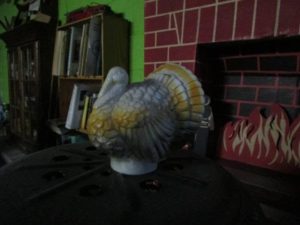
This turkey survived Thanksgiving. (Compliments of the eclectic Joey Archives: A plastic turkey from my 1960s youth, pictured in the faux cabin section of my basement.)
Joe Sapia, 60, is a lifelong resident of Monroe — in South Middlesex County, where his maternal family settled more than 100 years ago. He is a Pine Barrens naturalist and a gardener of organic vegetables and fruit, along with zinnias and roses. He draws inspiration on the Pine Barrens around Helmetta from his mother, Sophie Onda Sapia, who lived her whole life in these Pines, and his Polish-immigrant grandmother, Annie Poznanski Onda. He gardens the same backyard plot as did his Grandma Annie and Italian-American father, Joe Sr. Both are inspirations for his food gardening. Ma inspires his rose gardening. Joe is a semi-retired print journalist of almost 40 years. His work also is at @JosephSapia on Twitter.com, along with Facebook.com on the Jersey Midlands page.
Article and photos by Joe Sapia
Note: The yard references are to my house in the section of Monroe between Helmetta and Jamesburg in South Middlesex County. My yard is in a Pine Barrens outlier on the Inner Coastal Plain, the soil is loamy, and my neighborhood is on the boundary of Gardening Zones 6b (cooler) and 7a (warmer). Notes and photographs are for the period covered, unless otherwise noted.

Looking upstream on the Delaware River at dusk from the historic iron bridge connecting Stockton, Hunterdon County, New Jersey, to Centre Bridge, Bucks County, Pennsylvania. The photograph was taken from the New Jersey side, looking toward Pennsylvania. The bridge was built in 1926 and refurbished in 2007. This section of the Delaware River is part of the National and Wild Scenic River System.
DELAWARE RIVER: After the Pine Barrens, the Delaware River is my favorite local ecosystem. I especially love the part of the river north of Trenton. There, an approximately 150-mile stretch of the river, from Washington Crossing at Mercer County, New Jersey, and Bucks County, Pennsylvania, north to Hancock, New York, is part of the National and Wild Scenic River System. Aside from what the System name suggests, eligibility for the System requires the river have protection in place and be free-flowing. At 330 miles, the Delaware River is the longest free-flowing river, meaning it is uninterrupted by a dam, east of the Mississippi River. Next summer, consider tubing the Delaware. Meanwhile, these two books can keep you company, “Natural Lives, Modern Times – People and Places of the Delaware River” by Bruce Stutz and “The Illustrated Delaware River – the History of a Great American River” by Hal Taylor.

Looking downstream on the Delaware River from the Centre Bridge-Stocton bridge. New Jersey is to the left, Pennsylvania to the right. This section is part of the National and Wild Scenic River System.
HOUSE SPARROWS: I watch many a bird perched in the shrubs outside my living room window at Monroe, Middlesex County. This week, I noticed a small bird of chestnut, black, and gray – a house sparrow, “Passer domesticus.” Beautiful! Alas, it is non-native, a species from Eurasia and North Africa introduced to North America in New York in 1851, according to the National Audubon Society. “Many people regard house sparrows as undesirables in their yards, since they aren’t native and can be a menace to native species,” according to Cornell University’s All About Birds website. “House Sparrows are so closely entwined with people’s lives that you probably will find them around your home even without feeding them.” (A shout out to two New Jersey Audubon Society naturalists for heading me in the proper direction in identifying this bird: Pete Bacinski, retired, and Scott Barnes, active. I am a pretty bad birder, so I appreciate the help.)
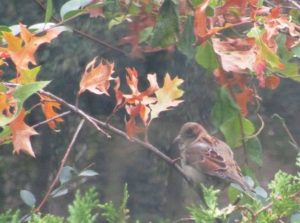
A house sparrow in the front yard of my house in Monroe, Middlesex County.
CANADA GEESE: Speaking of beautiful but pain-in-neck birds, I observed Canada geese in different locales during the week. I have a funny relationship with Canada geese, “Branta canadensis,” finding them to be admirable parents and elegant when personally connecting with them, while in a standoffish way viewing them as pooping, polluting pests. This week, I leaned in a positive direction. (If you get a chance, observe Canada geese as a couple. “They mate for life with very low ‘divorce rates,’ and pairs remain together throughout the year,” according to Cornell University’s All About Birds website. Also, they care for their young as very protective parents. Perhaps a lesson for humans, “Homo sapiens.”)
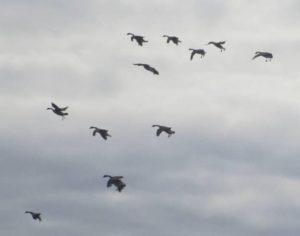
Canada geese landing at a retention pond near Route 33 in Monroe, Middlesex County.
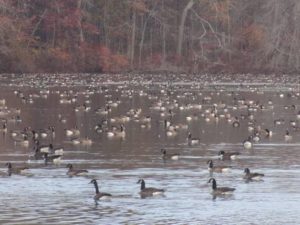
Canada geese dot ETRA Lake in East Windsor, Mercer County.
VOICES FROM AFIELD, No. 1, WILL SIGLE: Fellow Monroe, Middlesex County, resident Will Sigle, a retired science teacher, checked in with some thoughts on farming and wildlife. One of the things Will mentioned was about his yard, “Last year, I had a red-tail (hawk, ‘Buteo jamaicensis’) dining on a daily basis. Amazing how quiet the yard was when he was around.” Ah, yes, when a raptor is around, smaller birds know to beware.
BIRDING NOTES: While in my house in Monroe, Middlesex County, one night this week, I heard a great horned owl, “Bubo virginianus,” hooting. This species is an early breeder, so I am figuring it was either a territorial call or a call for a mate. I went outside to get a better idea where it was calling from, but it had stopped by the time I got outside. Keep your ears open for this resonating baritone. Years ago, one must have landed in a tree near my bedroom in the Monroe farmhouse I was living in at the time and started calling – Man, did I come alive in surprise when I first heard it.

A pumpkin patch at the Fresh Ponds section of South Brunswick, Middlesex County.
DEER RUT: One night, this week, I heard a familiar rustle in the fallen leaves of my neighborhood. I waited and, yes, a doe and her two young walked through a neighbor’s yard and onto my street. Hiding in bushes in my front yard, I watched them for maybe 10 or 15 minutes, only 125 feet or less away. They were jumpy, but they never fled. Finally, I lost sight of them up the street. This week, I saw no bucks, as I had been seeing in recent weeks. So, I suspect the mating season, or rut, of deer, “Odocoileus virginianus,” is at its peak – with bucks and receptive does holed up in secluded spots in the woods.
THE ENIVIROMENTALISM OF DEER HUNTING: “U.S.1” newspaper recently had an interesting article on how deer-hunting is now environmentally in vogue, at least in some circles such as in the Hopewell Valley area on the boundary of Mercer, Somerset, and Hunterdon counties. When this was mentioned here recently, it generated quite a bit of pro-hunting chatter. The recent “U.S.1” article, http://princetoninfo.com/index.php/component/us1more/?Itemid=6&key=11-8cover.
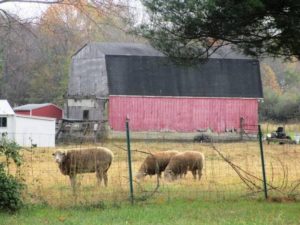
Sheep at a farm in Monroe, Middlesex County.
FIRE IN THE PINES: The state Pinelands Commission is considering fire-break permits in the Pine Barrens area it covers – basically from the Route 528/Cassville section of Jackson, Ocean County, and south. The Pine Barrens are susceptible to wildfire because of their well-drained, sandy soil with dry, dense, and highly flammable vegetation. Fire-breaks can stop fires or at least hopefully slow their threat.
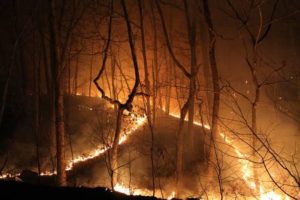
Helmetta’s Joey Slezak took this photograph of a state Forest Fire Service control-burn a few years ago in the Pine Barrens around Helmetta. The Pine Barrens around Helmetta are not part of the state-regulated “Pinelands.” (Photo copyrighted by Joey Slezak).
VOICES FROM AFIELD, NO. 2, VERONICA VAN HOF: Veronica Van Hof, director of the Unexpected Wildlife Refuge a bit south of the Midlands in Buena Vista, Atlantic County, checked in, regarding how spring peeper treefrogs, “Pseudacris crucifer,” normally early spring callers, have been heard in recent weeks: “We heard peepers recently, too! I was surprised but they’re so unmistakable.” Veronica also noted the arrival of winter visitors, bufflehead ducks, “Bucephala albeola,” down from Canada, “Just got our first buffleheads today” — Sunday, November 12 – “a pair lazily dabbling around the pond.”
DAIRY FARMS: In recent years, there has been a resurgence in dairying (at a scaled-down level) and home delivery of dairy products. But in my youth in the 1960s, local commercial dairy farms, along with home delivery, were a way of life – in my case, Forsgate Farms of Monroe, Middlesex County, at my Monroe home and Decker’s Dairy of Hightstown-East Windsor, Mercer County, at my elementary school, St. Mary School in South River, Middlesex County. The Hightstown-East Windsor area also had Conover’s Dairy. Conover’s Dairy, for example, closed in 1972, according to the East Windsor township website. (See https://www.east-windsor.nj.us/conovers-dairy.)

A Conover’s Dairy and Decker’s Dairy display at the Hightstown Diner in Mercer County.
PERRINEVILLE LAKE PARK: New Jersey’s Coastal Plain, as its name suggests, is generally flat. But at Perrineville Lake Park in Millstone and Roosevelt, both in Monmouth County, the land is hilly, thanks to the cuesta geological formation. This hilly formation generally runs from Sandy Hook in Monmouth County to the Philadelphia area, dividing the sandy soil Outer Coastal Plain and the generally dark soil Inner Coastal Plain. The park is about 1,200 acres and includes the lake, formed by the damming of Rocky Brook, woods, and field. More on the park, http://monmouthcountyparks.com/documents/130/PerrinevilleForWeb.pdf and https://www.monmouthcountyparks.com/page.aspx?Id=2550.
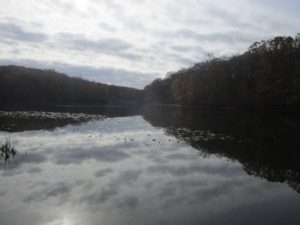
Perrineville Lake in Millstone, Monmouth County.
DELAWARE AND RARITAN CANAL: The Delaware and Raritan Canal’s main shipping channel ran about 30 miles between the areas of New Brunswick, Middlesex County, and Trenton, Mercer County. Another canal, the feeder canal, replenished the main canal with water from the Delaware River. The feeder canal also ran about 30 miles between the areas of Frenchtown, Hunterdon County, and Trenton. The feeder canal later was used for shipping, too. The canal operated for about 100 years from the 1830s to the 1930s. Today, the canal provides easy hiking, bicycling, boating, and fishing along both main and feeder canals. More information, http://www.dandrcanal.com.
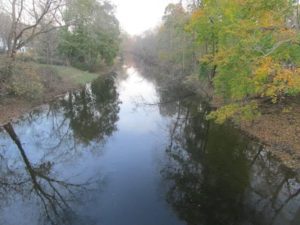
Looking south on the Delaware and Raritan Canal’s feeder at Stockton, Hunterdon County.
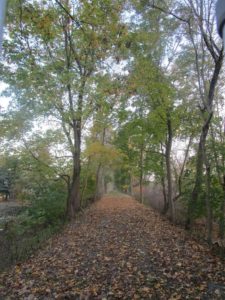
The Delaware and Raritan Canal, here the feeder canal, towpath at Stockton, Hunterdon County.
OCEAN TEMPERATURES: The Atlantic Ocean temperature at Sandy Hook was about 49 degrees over Friday-Saturday, November 17-18.
SUNRISE/SUNSET: For November 19, Sunday, to November 25, Saturday, the sun will rise about 6:50 to 6:55 a.m. and set about 4:35 p.m. For November 26, Sunday, to December 2, Saturday, the sun will rise about 6:55 to 7:05 a.m. and set about 4:30 to 4:35 p.m.
WEATHER: The National Weather Service forecasting station for the area is at http://www.weather.gov/phi/.
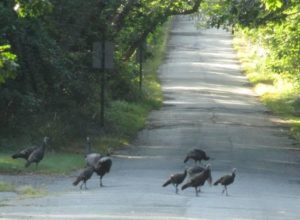
Happy Turkey Day – Thanksgiving, Thursday, November 23. In the photograph, wild turkeys, “Meleagris gallopavo,” cross a road in the Pine Barrens around Helmetta in 2015.
Joe Sapia, 60, is a lifelong resident of Monroe — in South Middlesex County, where his maternal family settled more than 100 years ago. He is a Pine Barrens naturalist and a gardener of organic vegetables and fruit, along with zinnias and roses. He draws inspiration on the Pine Barrens around Helmetta from his mother, Sophie Onda Sapia, who lived her whole life in these Pines, and his Polish-immigrant grandmother, Annie Poznanski Onda. He gardens the same backyard plot as did his Grandma Annie and Italian-American father, Joe Sr. Both are inspirations for his food gardening. Ma inspires his rose gardening. Joe is a semi-retired print journalist of almost 40 years. His work also is at @JosephSapia on Twitter.com, along with Facebook.com on the Jersey Midlands page.
Article and photos by Joe Sapia
Note: The yard references are to my house in the section of Monroe between Helmetta and Jamesburg in South Middlesex County. My yard is in a Pine Barrens outlier on the Inner Coastal Plain, the soil is loamy, and my neighborhood is on the boundary of Gardening Zones 6b (cooler) and 7a (warmer). Notes and photographs are for the period covered, unless otherwise noted.
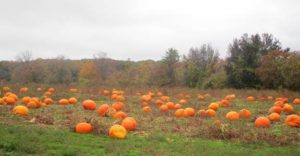
Pumpkins and fall foliage, both taking a last stand for the season, at the Red Wagon Farm Market on Route 33 and Smithburg Road/Route 527-A in Manalapan, Monmouth County.
SNOWBIRDS: I saw the first “snowbirds,” or dark-eyed juncos, “Junco hyemalis,” of the season on Tuesday, November 7, Election Day, around sunrise at St. James Cemetery in Monroe, Middlesex County. The birds are easy to identify by their gray tops and white undersides – “gray skies above, snow below” – and the white edges of their splayed tails as they take off. My rule of thumb is to look for these birds around Halloween, October 31, arriving for the cold weather from as close as the high ground of North Jersey or Pennsylvania and as far away as Canada. Around my yard, I look for these small birds on the ground under the bird-feeder or in bushes. I will see them around my yard to about mid- to late April.
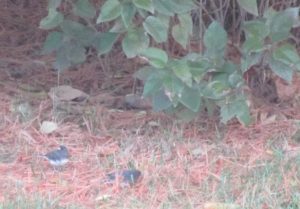
I saw the first “snowbirds,” or dark-eyed juncos, of the season Tuesday, November 7, Election Day, at St. James Cemetery in Monroe, Middlesex County. These birds arrive from the north for the cold-weather season.
VOICES FROM AFIELD, MORE WINTER BIRDS: Diane Larson, a long-time gardening mentor, checked in on the afield side, regarding Beaver Dam Creek in Brick, Ocean County. “Another bird sign of winter – the buffleheads (“Bucephala albeola’’) and mergansers (genus “Mergus”) arrived in Beaver Dam Creek right on schedule – saw them Saturday (November 4) for the first time. We also have otters (“Lutra Canadensis”). They are very elusive, but we’ve seen them and heard them splashing in the water around 8:00 p.m. one night (during) the last week of October. We went outside and tried to see them, but they swam away. All we saw was their wake and heard their grunts.”
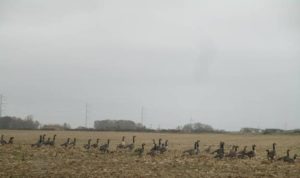
Canada geese, “Branta canadensis,” on the Skeba Farm in the Applegarth section of Monroe, Middlesex County.
BIRDS IN MY YARD: As I was doing yardwork, birds were feasting on corn hearts at my backyard bird-feeder: dark-eyed junco, “Junco hyemalis”; mourning dove, “Zenaida macroura”; tufted titmouse, “Baeolophus bicolor”; and Carolina chickadee, “Poecile carolinensis.”
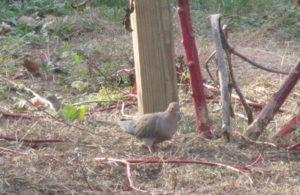
A Mourning Dove at my Backyard Bird-feeder

A Tufted Titmouse at my Backyard Bird-Feeder
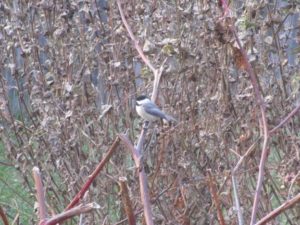
A Chickadee at my Backyard Feeder
GARDEN AND YARD: As I cut the lawn, hopefully for the last time of the year, I smelled wild onions I had mowed down. A bittersweet scent – one pointing back at the year’s peak of vegetable growing, one pointing to a gardening season that lingers. The Jamesburg-to-New Brunswick area of Middlesex County got down to about 20 degrees on the Friday-Saturday, November 10-11, overnight, pretty much bringing an end to the warm weather gardening season. However, I did find a few cherry tomatoes in my garden. (I have a cool weather crop of carrots planted. So, I am hoping for some kind of harvest.) So, this week, I cut the lawn, dumped my last barrel of gardening water, and mowed down the garden, except for the carrots. As for the yard work, I try to get that all done by Thanksgiving.
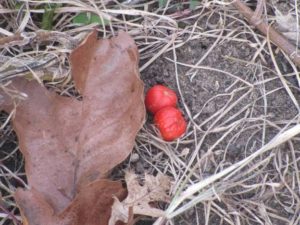
I found these cherry tomatoes in my garden. The top one was in good condition and I popped it into my mouth right in the yard and ate it.
VOICES FROM AFIELD, NO. 2, LINGERING SPRING: Last week, I mentioned I thought I heard the call of a spring peeper treefrog, “Pseudacris crucifer,” at Farrington Lake on the boundary of South Brunswick, East Brunswick, and North Brunswick in Middlesex County. They are normally early spring callers. Jean Montgomerie, an environmental scientist who lives in Freehold and works in the Pine Barrens, said, “Those were spring peepers; I heard them last week too.” Spring, in the form of fall, is playing itself out again, this year.
NIGHT SKY: With the cold spell at the end of the week, I stood in my yard between about 10:30 p.m. and 11:30 p.m. and looked at the night sky. With the temperature at about 23 degrees and very little moisture in the air (with a dewpoint of about 8 degrees), it was one of the clearest night skies I recall, with great views of Auriga (overhead/east); Pleiades, or Seven Sisters (overhead); Orion (southeast); the Great Square of Pegasus (southwest); Cassiopeia (northwest); and the North Star. Take advantage of cold, dry fall and winter overnights. Get a revolving star chart, turn off the outside lights, go outside and acclimate your eyesight to the darkness, and look into the night sky.
THE MOON: The moon is waning from the Full Frost Moon of the November 3-4 overnight. The next full moon is the Long Night Moon on the December 2-3 overnight.

The morning moon, with the changing colors of the fall foliage underneath, at St. James Cemetery in Monroe, Middlesex County. The moon is waning from the Full Frost Moon of the November 3-4 overnight. The next full moon is the Long Night Moon on the December 2-3 overnight.
FALL FOLIAGE: The changing colors of fall foliage are all over the place – some past full color, some peaking, some yet to come. I take the colors as they come, rather than concentrating on a peak.

The changing colors of the fall foliage along Interstate 195 in Jackson, Ocean County.
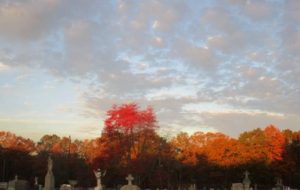
The rising sun’s light hits the top of the trees, lighting up the fall colors, at St. James Cemetery in Monroe, Middlesex County.
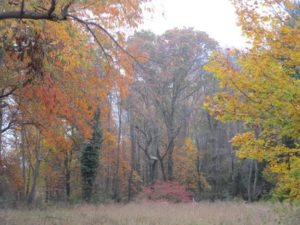
The changing colors between Davidson Mill Park and Pigeon Swamp in South Brunswick, Middlesex County.
DRIVE-BY NATURALIST, RED-TAILED HAWK: As I was returning home from my normal Sunday routine of lunch at the Hightstown Diner in Mercer County, I crossed the Millstone River on the boundary of Cranbury, Middlesex County, and East Windsor, Mercer County. On the Cranbury side, a large bird flew out of the trees, then low along the roadway – a red-tailed hawk, “Buteo jamaicensis.” I cranked off a shot on my camera. Not a good shot, but that is photojournalism – you take what you get, because the news does not necessarily stop for the journalist. The photo, at least, puts in perspective how low the bird was.
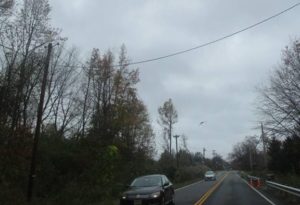
A red-tailed hawk flies low along a roadway on the boundary of Cranbury, Middlesex County, and East Windsor, Mercer County.
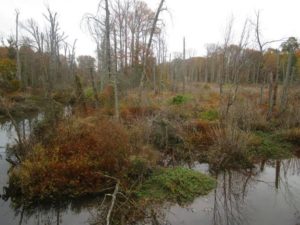
The Millstone River on the boundary of Cranbury, Middlesex County, and East Windsor, Mercer County.
VOICES FROM AFIELD, NO. 3, DEER RUT: I continue seeing normally hidden male deer, “Odocoileus virginianus,” because it is the mating season, or rut. This week, I saw one in southern Monroe, Middlesex County, at night. Then, as I was driving to work one morning in daylight, a deer bolted across a paved road in the Jamesburg Park Conservation Area in the Pine Barrens around Helmetta, Middlesex County. I did not get a good look at the deer, but, based on the way it bolted across the street and because I saw no others, my guess is it was a buck. Paul Migut checked in from South River, Middlesex County: “Spotted buck behind my firehouse. He’s been chasing two does around here.” Again, be careful driving during the rut, which should last until about mid-December.
CLOUDS: This week’s cloud shots are from St. James Cemetery in Monroe, Middlesex County. My family has had a plot there for more than 100 years, since my maternal grandfather, Michael Onda, died in 1917, October.

Clouds over St. James Cemetery in Monroe, Middlesex County.

More clouds from St. James Cemetery in Monroe, Middlesex County.

And more clouds from St. James Cemetery in Monroe, Middlesex County.
VOICES FROM AFIELD, N0. 4, SWIMMING RIVER: Rik van Hemmen, sailor and advocate for the Navesink River watershed, Monmouth County, checked in: “Two weeks ago, just before I hauled my Sea Bright skiff for the winter, we had a perfect tide going up the Swimming River with friends who had never done it before. As is common, it blew their minds to see all this natural beauty.”

Fall on the Swimming River in Monmouth County. (Photograph copyright 2017 by Rik van Hemmen.)
OCEAN TEMPERATURES: Atlantic Ocean temperatures on the New Jersey coast were about 50 degrees to 53 degrees over the November 11-12 weekend.
SUNRISE/SUNSET: For November 12, Sunday, to November 18, Saturday, the sun will rise about 6:40 to 6:45 a.m. and set about 4:35 to 4:40 p.m. For November 19, Sunday, to November 25, Saturday, the sun will rise about 6:50 to 6:55 a.m. and set about 4:35 p.m.
WEATHER: The National Weather Service forecasting station for the area is at http://www.weather.gov/phi/.
IN THE BACKYARD: As I was wrapping up this week’s “Notes from Garden and Afield,” I took a soda break. While in the kitchen, I grabbed four gourds I had on display on the table, opened the back door, stood on the back porch, and threw the gourds across the lawn into the garden. I threw one into a pitch pine, “Pinus rigida,” bordering lawn and garden. A bird must have been in the tree, because a large bird flew out and past me eye-high. Wow! On that note….

Say, good night, Pumpkin Person. (A pumpkin person at the Red Wagon Farm Market on Route 33, Manalapan, Monmouth County.)
Joe Sapia, 60, is a lifelong resident of Monroe — in South Middlesex County, where his maternal family settled more than 100 years ago. He is a Pine Barrens naturalist and a gardener of organic vegetables and fruit, along with zinnias and roses. He draws inspiration on the Pine Barrens around Helmetta from his mother, Sophie Onda Sapia, who lived her whole life in these Pines, and his Polish-immigrant grandmother, Annie Poznanski Onda. He gardens the same backyard plot as did his Grandma Annie and Italian-American father, Joe Sr. Both are inspirations for his food gardening. Ma inspires his rose gardening. Joe is a semi-retired print journalist of almost 40 years. His work also is at @JosephSapia on Twitter.com, along with Facebook.com on the Jersey Midlands page.
Article and photos by Joe Sapia
Note: The yard references are to my house in the section of Monroe between Helmetta and Jamesburg in South Middlesex County. My yard is in a Pine Barrens outlier on the Inner Coastal Plain, the soil is loamy, and my neighborhood is on the boundary of Gardening Zones 6b (cooler) and 7a (warmer). Notes and photographs are for the period covered, unless otherwise noted.
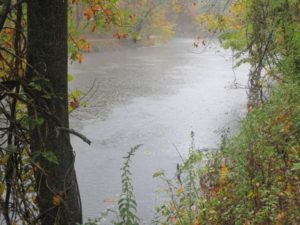
Nor’easter rain pelts the Delaware and Raritan Canal at Kingston, which overlaps the boundary of Franklin, Somerset County, and South Brunswick, Middlesex County. This photograph was taken on the Somerset County side of Route 27.
NOR’EASTER: The Sunday-Monday, October 29-30, nor’easter dropped large amounts of rain throughout the Jersey Midlands. The National Weather Service unofficial high totals from weather stations in the Jersey Midlands portion of seven counties: Hunterdon, up to 4.91 inches in High Bridge; Somerset, up to 4.5 inches in Bernards; Middlesex, up to 3.79 inches in northeast South Brunswick; Monmouth, up to 4.74 inches in West Long Branch; Ocean, up to 5.45 inches in Berkeley; Burlington, up to 4.62 inches in Roebling; and Mercer, up to 5.42 in west Princeton.
The nor’easter also brought reported maximum wind gusts of: Hunterdon, 45 miles per hour at Frenchtown; Middlesex, 52 MPH in the Raritan River/Perth Amboy area; Monmouth, 49 MPH at north Long Branch; Ocean, 58 MPH in the Beach Haven area; Burlington, 47 MPH at Jobstown; and Mercer, 40 MPH at Mercer County Airport.
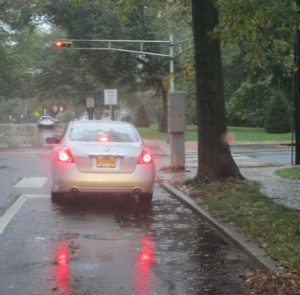
Water pools on a roadway in Princeton, Mercer County, during the nor’easter Sunday, October 29.
NOR’EASTER, BEFORE AND AFTER: Before the Sunday-Monday, October 29-30, nor’easter, all seven Midlands counties had a deficit of rainfall over the last three months. After the nor’easter, only Hunterdon and Mercer have deficits. According to National Weather Service, three-month rainfalls as of Thursday, November 2, were: Hunterdon, 10.7 inches total over the last three months, minus 1.8 inches; Somerset, 12.4 inches, plus .2 inches; Middlesex, 12.0 inches, even; Monmouth, plus .2 inches; Ocean, 12.0 inches, plus .7 inches; Burlington, 11.8 inches, plus .2 inches; and Mercer, 10.2 inches, minus 1.8 inches.
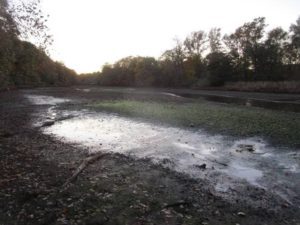
Farrington Lake – here, on the boundary of South Brunswick and East Brunswick looking to North Brunswick, all in Middlesex County – in the days before the Sunday-Monday, October 29-30, nor’easter.
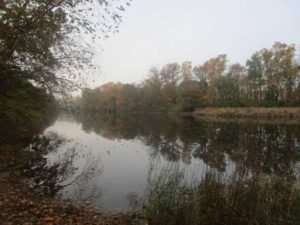
The same view of Farrington Lake in the days after the nor’easter.
FALLEN LEAVES ON ROADWAYS: Motorists, be careful of braking with fallen leaves on the roadway, especially in wet conditions.
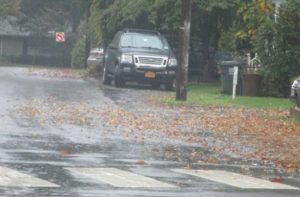
Leaves cover a roadway in the Kingston section of Franklin, Somerset County, during the October 29-30 nor’easter.
FALL FOLIAGE: The fall colors have really brightened, although there is still much green out there and a lot that has already turned color. I am thinking we are in the midst of our (erratic) peak, so enjoy it while it lasts.
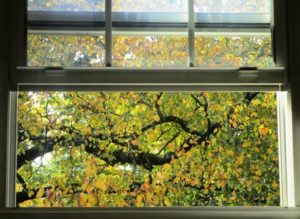
The changing colors of the fall foliage in New Brunswick, Middlesex County, as seen through the window of the Rutgers University Plangere Writing Center.
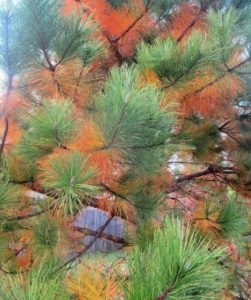
Shattering two myths: One, pine trees are evergreens, but they do shed needles. Here, a pitch pine, “Pinus rigida,” the most common pine of the New Jersey Pine Barrens. This one is in my backyard in Monroe, Middlesex County, but transplanted from the wilds of the Pine Barrens of Monmouth County. Two, the Pine Barrens are not barren. Actually, the Pines are a great place to see the changing colors of the fall, contrasting with the greens of pitch pines and other evergreens.
DEER RUT: As I have mentioned, I am seeing something I do not normally see – adult male deer, “Odocoileus virginianus.” But it is the mating season, or rut, so bucks are moving. On the night of Wednesday, November 1, I saw a buck as I drove through an East Brunswick section of the Jamesburg Park Conservation Area. He trotted into the woods. We appear to still be in the first phase of the rut – bucks following female deer in search of receptive does. The second phase will be mating, the third phase being the rut winding down – the rut lasting until about mid-December. With sex-crazed deer running around, be careful driving.
VOICE FROM AFIELD, JOAN GETAZ ZUMOFF: I still not have seen any “snowbirds,” or juncos, “Junco hyemalis,” at my house in Monroe, Middlesex County. But I expect them any day down for the colder weather from probably as far north as Canada. Actually, they are likely around already and I just have not seen any yet, because Joan Getaz Zumoff checked in just below the Midlands — from Gloucester Township, Camden County, where she had a first sighting Oct. 27. My rule of thumb for snowbirds at my house is around Halloween, October 31. But this has been a wacky year with the weather.
IS IT FALL YET?: Depending on the day, it could be frosty or summer-like. This week, I was shooting photographs at Farrington Lake in Middlesex County. At the part of the lake on the boundary where North Brunswick, East Brunswick, and South Brunswick meet, I am pretty sure I heard a spring peeper treefrog, “Pseudacris crucifer.” The normal time to begin hearing their calls is around early March – that harbinger of spring that sounds like sleigh bells coming from swamps – and, then, they are pretty much done as the spring warms up toward summer.
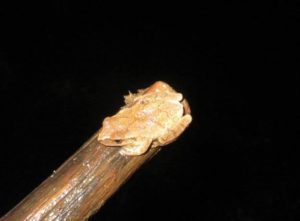
I photographed this spring peeper treefrog in the Manalapan Brook floodplain in Monroe, Middlesex County, in March. They are early spring callers. But I am pretty sure I heard the species calling this week at Farrington Lake on the boundary of North Brunswick, East Brunswick, and South Brunswick, all in Middlesex County – one of those aberrations of nature.
BLOOMING FLOWERS: Garden flowers continued blooming. In Kingston, on the South Brunswick, Middlesex County, side, for example, I saw a beautiful planting of zinnias along Route 27 in front of the Eno Terra restaurant.

Here in Kingston on the South Brunswick, Middlesex County, side of Route 27, grows an ornamental planting of zinnias with the fall foliage colors in the background.
VOICE FROM AFIELD, CHRIS BEVINS: Chris Bevins checked in from Monroe, Middlesex County, where he works for the Utility Department: “I was working on a project this morning and the irrigation pond at the end of England Road on the field had a mated pair of freshwater otters eating fish and frolicking.” I hope to see them, because I have never seen an otter, “Lontra canadensis.”
MY GARDEN: My vegetable garden – between Helmetta and Jamesburg in South Middlesex County — took a licking because of heavy rain over the summer. Other than the colorful and pollinating-attracting zinnias, it was a bad year – basically only a bit of sweet corn to show for the work. But, then this week, I harvested some of my early spring plantings of Lake Valley “Rainbow Blend” carrots. Now, I will watch to see how my late-season planting of carrots does.

Planted April 8 as part of my early crop, these Lake Valley “Rainbow Blend” heirloom carrots were harvested Sunday, October 29.
VOICE FROM THE GARDEN, PAUL MIGUT: Paul Migut, now in his early 60s, who has been gardening since childhood, reported in from South River, Middlesex County: “November 2, a balmy 75f. Garden cleaned out and tilled up. A few eggplants picked and one grape tomato plant still hanging in there. While no match for Pon’s garden from days of old” – a reference to his Uncle Stanley “Pon” Ceslowski and his garden in Monroe, Middlesex County – “my 20 feet by 20 feet section still manages to provide vegetables for the two of us” – Paul and his wife, Karen – “and then some.”

The “last of the eggplants,” according to Paul Migut, from his South River, Middlesex County, garden.
DRIVE-BY NATURALIST, VULTURES: During the nor’easter, I came across these vultures in the Monmouth Junction section of South Brunswick, Middlesex County.
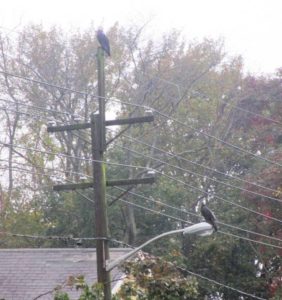
Vultures across the street from the Monmouth Junction Elementary School in South Brunswick, Middlesex County.
DRIVE-BY NATURALIST, HAZY SKY: On Thursday, November 2, I awoke to weather reports warning of fog. By the time I left the house around 8 a.m., though, there was no ground-level fog to speak of, but the sky had a haze. Sunshine fighting through that haze provided a beautiful view – one to photograph.

The sun breaks through the haze over the Jamesburg Park Conservation Area on the boundary of South Brunswick and East Brunswick, both in Middlesex County.
CLOUDS, NEW BRUNSWICK: Beautiful cloud views continue. This week, for example, at New Brunswick, Middlesex County – the Douglass-Cook campus of Rutgers University and along the Raritan River.
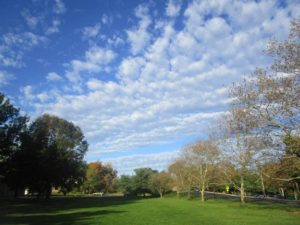
Clouds above the Douglass-Cook campus at Rutgers University in New Brunswick, Middlesex County.

Over the Raritan River from George Street in New Brunswick, Middlesex County.
RUTGERS UNIVERSITY SQUIRRELS: As I walk through the Rutgers University College Avenue and Douglass-Cook campuses in New Brunswick, Middlesex County, Mondays through Fridays, I find the squirrels, “Sciurus carolinensis,” entertaining and numerous. If I were a squirrel in New Brunswick, I probably would pick the garden-y campus, rather than the urban sectors.

This squirrel has quite a bit of red tint.
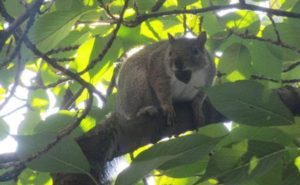
Acting as a squirrel with acorn in mouth.
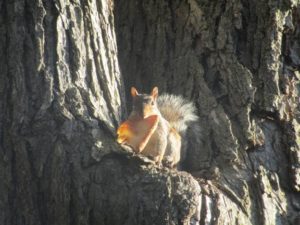
This squirrel was acting like a human, with some kind of bread in its mouth.
OCEAN TEMPERATURES: Atlantic Ocean temperatures on the New Jersey coast were about 60 degrees to 62 degrees over the November 4-5 weekend.

On the banks of the old Raritan River, looking downstream from New Brunswick, across the river to Highland Park, both in Middlesex County.
CHANGE THE CLOCKS: We switch from Daylight Savings Time to Standard Time November 5, Sunday, at 2 a.m., the clocks moving back to 1 a.m.
SUNRISE/SUNSET: For November 5, Sunday, to November 11, Saturday, the sun will rise about 6:35 a.m. set about 4:45 p.m. For November 12, Sunday, to November 18, Saturday, the sun will rise about 6:40 to 6:45 a.m. and set about 4:35 to 4:40 p.m.
WEATHER: The National Weather Service forecasting station for the area is at http://www.weather.gov/phi/.

Pictured is the Full Frost Moon on the November 3-4 overnight. The next full moon is the Long Night Moon on the December 2-3 overnight.
A PARTING NOTE, HAIKU: The Japanese poetry style of 5 syllables, 7 syllables, and, finally, 5 syllables:
Look into the woods –
The leaves are changing colors.
Yellow, orange, red.
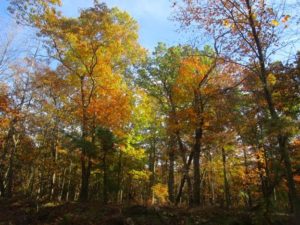
Leaves changing colors in the Pine Barrens around Helmetta, Middlesex County.
Joe Sapia, 60, is a lifelong resident of Monroe — in South Middlesex County, where his maternal family settled more than 100 years ago. He is a Pine Barrens naturalist and a gardener of organic vegetables and fruit, along with zinnias and roses. He draws inspiration on the Pine Barrens around Helmetta from his mother, Sophie Onda Sapia, who lived her whole life in these Pines, and his Polish-immigrant grandmother, Annie Poznanski Onda. He gardens the same backyard plot as did his Grandma Annie and Italian-American father, Joe Sr. Both are inspirations for his food gardening. Ma inspires his rose gardening. Joe’s work also is at @JosephSapia on Twitter.com, along with Facebook.com on the Jersey Midlands page.









































































